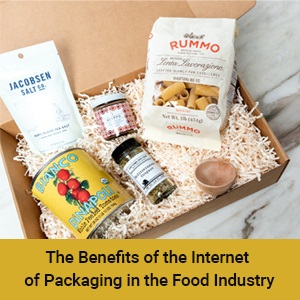The Benefits of the Internet of Packaging in the Food Industry

What is the Internet of Packaging?
In the "Internet of Packaging," distinctive, machine-readable packaging continuously exchanges information with the outside world via scanners and mobile devices. The cloud-based SaaS technology allows us to manage the traceable IDs that individual products acquire. The cloud can therefore store and update data regarding specific packages at any time throughout the product lifecycle.
When application developers have access to the data and content related to the packaging, the "Internet of Packaging" will realize its full potential. In the interim, however, IoP already offers significant solutions for consumer marketing, brand engagement, brand protection, tracking, process optimization, and other issues. And the way things are done is already being disrupted. We no longer have a value chain; instead, we have a value network as a result of the Internet of Packaging.
The packaging of products is being revolutionized by the Internet of Packaging (IoP). It enables information about specific packages to be registered and updated in the cloud throughout their existence using Near Field Communication (NFC) chips, smart labels, radio frequency identification (RFID), and QR codes.
The market for internet-connected packaging is anticipated to grow at a CAGR of 10.29% from 2022 to 2030, reaching USD 47.8 billion.
Internet of packaging in the food industry
The potential of Internet of Packaging is greatest when used throughout the value chain. There are numerous prospects for the Internet of Packaging in the Food Industry due to the need for more sustainable foods and packaging, less food and packaging waste, increased product authenticity, improved food safety, better branding, and improved monitoring and tracing of products.
Engaging the whole value chain increases benefits and reduces implementation costs. For instance, IoP can address food safety via tracking and tracing, reduce food waste by determining shelf life via smell, vision, and taste sensors, encourage more reuse and recycling by providing location-specific package disposal information, and step up efforts to make the sourcing of food and packaging materials more sustainable.
In order to increase food safety and decrease food waste, IoP for the food business also engages with customers. For instance, blockchain-based IoP enables tight track-and-trace over the full value chain, improving food safety for consumers. It also operates securely and autonomously.
Food waste can be reduced by developing sensors that can detect oxygen, specific bacteria, or other molecules. Chemically complex quality criteria such as taste, aroma, toxicity, or freshness can be addressed by these sensors. These sensors are based on medical technology. Other sensors can release activated carbon in order to render products inactive so that they can be properly disposed of after their expiration date has passed or after they have been exposed to temperature and humidity that degrade their quality.
Benefits of the Internet of Packaging
Thanks to the Internet of Packaging, manufacturers can now give customers up-to-date information about their products. Manufacturers now have a simpler way to communicate with customers directly and monitor the status of their products from the point of creation until the customer receives them. The Internet of Packaging has provided significant opportunities for manufacturers in marketing, brand interaction, image management, tracking, optimization, and other areas.
Additionally, because of digitization, better tracking, and increased customer interaction, demand for the Internet of Packaging is predicted to rise. Packaging manufacturers are utilizing IoP to boost operational effectiveness and enhance customer service. They can monitor a range of environmental aspects, including water and energy use, thanks to the Industrial Internet, which consists of intelligent equipment and sensors linked together wirelessly.









